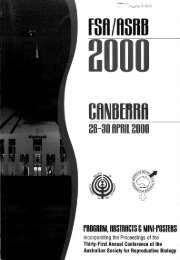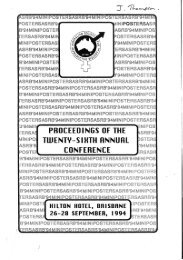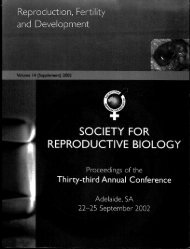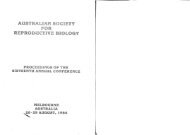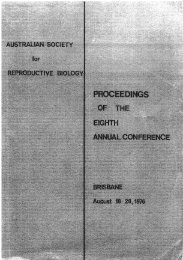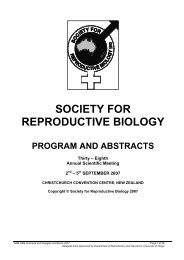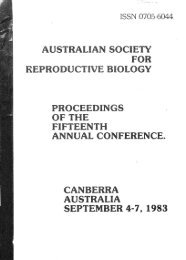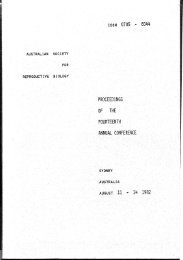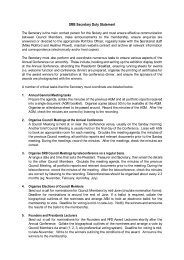N OCIETY' - the Society for Reproductive Biology
N OCIETY' - the Society for Reproductive Biology
N OCIETY' - the Society for Reproductive Biology
You also want an ePaper? Increase the reach of your titles
YUMPU automatically turns print PDFs into web optimized ePapers that Google loves.
THE EFFECTS OF TARGETED DISRUPTION OF THE CYP 19 (AROMATASE) GENE ONFOLLICULOGENESIS IN MICEKara L Britt, Ann E Drummond, Margaret E E Jones, Mitzilee Dyson, Nigel G Wre<strong>for</strong>d 1 ,Evan R Simpson and Joc.k K FindlayPrince Henry's Institute ofMedical Research, PO Box 5152, Clayton, Victoria 3168 andIDepartment of Anatomy, Monash University, Clayton, Victoria 3168, Australia.IntroductionA primary function of estrogen is to maintain <strong>the</strong> femalereproductive tract, notably ovarian folliculogenesis.Aromatase, a cytochrome P450 (P450 arom ) encoded by <strong>the</strong>cyp19 gene, catalyses <strong>the</strong> conversion of C l9 androgens toestrogens. Estrogen exerts its actions via <strong>the</strong> estrogenreceptors (ER), ERa and ERp, which are prevalent ongranulosa cells [1]. An aromatase knockout mouse(ArKO), generated via disruption of exon 9 of <strong>the</strong> cyp 19gene [2], allowed us to examine <strong>the</strong> local role of estrogenin ovarian folliculogenesis.Materials and MethodsBody, ovarian, gonadal fat and uterine weights fromwildtype, heterozygous and ArKO mice at 10-12, 16-18,21-26, weeks and one year of age were measured. Serumand ovaries were utilised <strong>for</strong> fur<strong>the</strong>r analyses. Ovarieswere ei<strong>the</strong>r fixed in <strong>for</strong>malin and paraffin embedded, orfrozen in OCT compound. Paraffin sections of wildtype,heterozygote and ArKO ovaries were histologically· andstereologically assessed. The numbers of primary,secondary and antral follicles were calculated using avariation of <strong>the</strong> fractionator method [3].Results and DiscussionThe ovarian weights of ArKO mice were reducedcompared to wildtype littermates up to 21-26 weeks ofage, at which time <strong>the</strong> weight of <strong>the</strong> ArKO ovaries were< 50% of wildtype. By one year of age ovarian weighthad increased, possibly due to <strong>the</strong> increase in connectivetissue. Uterine mass was decreased in <strong>the</strong> ArKO, to 50%of wildtype at 10-12 weeks and< 25% by one year. Gonadal fat pad weights of ArKOmice were increased by 2-fold compared to wildtype at 2126 weeks. ArKO ovaries at 10-12 weeks contained anincreased number of primary follicles compared toheterozygote littermates, and less secondary follicles (Fig1). At 21-23 weeks of age <strong>the</strong> number of primary follicleswas still greater than that observed in wildtype andheterozygote mice. By one year of age <strong>the</strong>re were nosecondary or antral fo,llicles present in <strong>the</strong> ArKO ovary.At 21-23 weeks <strong>the</strong> oocytes of heterozygote primaryfollicles had greater nuclear diameters than wildtype (Het111lm vs WT 9Ilm). Secondary and antral follicles showeda similar difference when compared to ArKO (Het 151lmvs ArKO llllm; Het l61lm vs ArKO 121lm respectively).A block in follicle development and a lack of corpora lutea(CL) within <strong>the</strong> ovaries was reflected in infertility at allages studied. Histological examination demonstrated that<strong>the</strong> ArKO ovary degenerated with age. Haemorrhagiccystic follicles appeared in <strong>the</strong> ovary at 21 weeks of ageand atresia, as measured by TUNEL assay, was observedto increase as a function of age. Coincident with <strong>the</strong> lossof follicles, extensive tissue remodelling, exemplified byan influx of macrophages and collagen deposition, wasobserved in <strong>the</strong> ArKO ovaries.8620015010050o~~ 250oi. 200j § 150c~ 100;:f 50o20015010050oo WT• HET1 0 -1 2 wee ks• KOFig 1: Effect ofage (a,b)and genotype (X,y) onfollicle number.Different letters denoting significance (* no follicles at thisstage ofdevelopment observed).Serum gonadotrophin (FSH and LH) levels measured bvradioimmunoassay were found to be elevated in <strong>the</strong> ArKOmice, and continued to increase with age. Interestingly at 1012 weeks heterozygote animals had increased FSH and LHlevels compared to wildtype, whilst remaining lower thanArKO levels. Earlier studies showed an increase intestosterone and undetectable estradiol levels in <strong>the</strong> ArKOmice [2]. The impact of <strong>the</strong> 10% soy contained within <strong>the</strong>mouse chow on <strong>the</strong> ovarian phenotype was investigated usingmice raised from birth on soy-free mouse chow. ArKO micemaintained on a soy-free diet displayed an earlier onset of <strong>the</strong>phenotype, with reduced ovarian weight, increased gonadal fatpads, and <strong>the</strong> appearance of haemorrhagic cysts at an earlierage (16 weeks). These results imply that phytoestrogenswithin <strong>the</strong> diet were acting as estrogens within <strong>the</strong> ovary andfat deposits of <strong>the</strong> mice. Thus mice on a soy-free diet providea more comprehensive model of estrogen deprivation.In summary, age-dependent disruption of folliculogenesis andovulation was observed in ArKO female mice, accounting <strong>for</strong><strong>the</strong>ir infertility. It is not clear whe<strong>the</strong>r <strong>the</strong> ovarian phenotypeobserved in <strong>the</strong> ArKO mouse is a direct result of <strong>the</strong> loss ofestrogen, or an indirect result of <strong>the</strong> elevated gonadotrophinsand testosterone or both.[1] Drummond AE et al., Mol. Cell. Endo. 1999 149:153[2] Fisher CR et al., PNAS. (USA). 1998; 95: 6965-6970.[3] Gundersen HJG et al., APMIS 1988; 96:857-881.Supported by NH&MRC of Australia (Regkey 983212)Polyovular Follicles in <strong>the</strong> Pouch Young and Adult KangarooSusan N. Reinke l , Ian M. Gunn!, Marilyn B. Renfree 2 , Alan O. Trounson l1Institute ofReproduction and Development, Monash University, Clayton, Victoria, 3168, Australia; 2 Department ofZoology, University ofMelbourne, Parkville, Victoria, 3052, Australia.Introduction. Polyovular follicles (follicles containingmore than one oocyte)-have been observed in a numberof mammalian species including <strong>the</strong> human (1), dog (2),mouse (3), wild Norway rat (4) and goat (5). Generally,polyovular follicles occur more frequently in immatureovaries although <strong>the</strong>y are also found in adults. Inmarsupials, <strong>the</strong> occurrence of polyovular follicles hasbeen observed in <strong>the</strong> American opossum, Didelphismarsupialis (6) and <strong>the</strong> Australian native cat, Dasyurusviverrinus (7). Similarly, it is noted that polyovularfollicles were first, and only, observed in <strong>the</strong> kangarooby van Beneden during <strong>the</strong> 1880's as previously cited(6). The aim of this study was to investigate whe<strong>the</strong>rpolyovular follicles occurred in two species of sexuallyimmature and mature kangaroos.Materials and Methods. Both eastern grey kangaroos(Macropus giganteus) and red kangaroos (Macropusrufus) were shot at Dubbo and Gunbar in NSW. Redkangaroos were also collected at Nymagee (NSW) andeastern grey kangaroos at Dunkeld (Vic) and Narromineand Warren in NSW. One ovary was scavenged fromeach female pouch young (PY) (n=6, ages 120 to 261days) and adult (n=28) eastern grey kangaroos, and fromfemale PY (n=3, ages 67 to 135 days) and adult (n=14)red kangaroos. The age of adult kangaroos was notdetermined. Whole, uncut ovarian tissue was fixed <strong>for</strong>light microscopy and <strong>the</strong> top ten sections were examined<strong>for</strong> polyovular follicles. Polyovular follicles wereclassified according to <strong>the</strong> system used <strong>for</strong> opossumovaries (6): Germ cell nests: oocytes in mutual contactand surrounded by a layer of flattened granulosa cells(Fig. 1); Polyovular follicles type I: oocytes separated bygranulosa cells but still within a single follicle (Fig. 2);Polyovular follicles type II: oocytes in mutual contact(Fig. 3); Polyovular follicles type III: oocytes withinfollicle found in a linear arrangement.Results and Discussion. The follicle populationconsisted of monovular follicles although polyovularfollicles were also found in PY and adult material. Alltypes of polyovular follicles with <strong>the</strong> exception of typeIII were observed. In <strong>the</strong> adult red kangaroo polyovularfollicles never contained more than two oocytes whilepolyovular follicles in <strong>the</strong> adult eastern grey kangaroofrequently had more than two oocytes. The mostcommonly observed polyovular follicle type was that ofgerm cell nests which were found in both species of PYand only in eastern grey adults. As <strong>the</strong> ages of adultswas not recorded, it is possible that some of <strong>the</strong>seindividuals were juveniles that had not yet completedovarian development and that <strong>the</strong> germ cell nests presentwere in <strong>the</strong> process of separation. Ano<strong>the</strong>r explanation<strong>for</strong> <strong>the</strong> presence of polyovular follicles may beenvironmental conditions which, as previously reported,?lays .a significant part in reproductive developmentmcludmg <strong>the</strong> delay of sexual maturity (8). There<strong>for</strong>e,<strong>the</strong> incidence of polyovular follicles observed in thisstudy could be a result of environmental factors, such aschemical sprays and toxins, which have been known toeffect reproductive organs.Conclusions. Polyovular follicles occur in both red andeastern grey kangaroos. Adult eastern grey kangarooshad three types of polyovular follicles but <strong>the</strong>y appearedless common than in <strong>the</strong> eastern grey pouch young.Fig. 1. Germ cell nest from adult female eastern greykangaroo. H & E, x 250. Bar =33J.l.m.Fig. 2. An atretic Graafian follicle containing two ova fromadult female eastern grey kangaroo. H & E, x 63. Bar =135J.l.m.Fig. 3. Biovular follicle from adult female eastern greykangaroo. H & E, x 160. Bar=53 J.l.m.References1. Arnold L (1912) Anat Rec. 6: 413-422.2. McDougall K, Hay MA, Goodrowe KL, Gartley CJ, King WA(1997) J Reprod Fert. 51: 25-31.3. Fekete E (1950) Anat Rec. 108: 699-707.4. Davis DE, Hall 0 (1950) Anat Rec. 107: 187-192.5. Joshi C, Nanda BS, Saigal RP (1976) Anat Anz. 139: 299-304.6. Hartman CO (1926) Am]Anat. 37: 1-51.7. O'Donoghue CH (1912) AnatAnz. 41: 353-368.8. Newsome A E (1965) Aust J 'hJo. 13: 735-759.87



